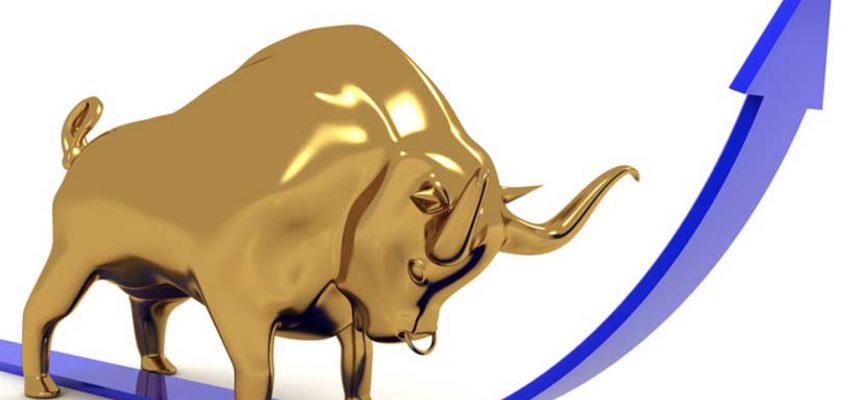Sprott says strong tailwinds are supporting the gold bull market.
Taper Fear Gives Way to Inflation Fear
June 6 (King World News) – Paul Wong, Market Strategist at Sprott: May 2021 was the best performing month for gold since July 2020, with the yellow metal climbing 7.79%. Silver rose 8.14% for the month. By contrast, platinum lost 1.10% and palladium fell 3.74%. Gold mining equities added 13.92% in May. For the year-to-date period ended May 31, 2021, gold was up 0.45%, silver gained 6.15%, platinum rose 11.01%, palladium returned 15.63% and gold mining equities gained 6.67%.
Gold Bullion Snaps Back
Spot gold rose $137.74 or 7.79% to close the month of May at $1,906.87, retracing all of the Q1 drawdown, one of gold’s most challenging quarters in several years. Gold formed a double bottom low at the end of March and has advanced in a very persistent narrow volatility range without pausing at any resistance levels, highly suggestive of systematic buyers returning. The much more volatile selling from September 2020 to March 2021 with downward breakaway price gaps was more representative of weak holders in capitulation selling. Gold has now broken out of its short-term bear channel and is advancing well above the 200-daily moving average (see Figure 1). MACD has also risen above the zero line, another technical confirmation of the uptrend resuming. We view $1,960 as the gold price’s next significant resistance level. Between $1,960 and gold’s all-time high of $2,075 is a gap zone that will need to be filled in.
Figure 1. Gold Bullion is Setting Up to Re-Test Highs
Since the COVID-19 vaccine breakthrough and the Democratic Blue Wave, markets have positioned into the reflation boom (e.g., value, small-cap stocks and commodities) and reduced traditional safe haven assets such as bonds and gold. As the reflation trade advanced, the next potential risk was a much sooner than expected Fed (Federal Reserve) taper and rate increase. Gold took the brunt of that risk, falling to $1,670 briefly. But as U.S. economic data came in hotter than expected in April and May, inflation moved to the forefront of risk. Market froth (hyper-growth and hyper-speculative equities) quickly sold off, growth versus value slumped further and gold staged a remarkable recovery. In short, “good reflation” quickly evolved into “bad inflation”.
In addition to the inflation shock, the U.S. dollar (USD) has fallen and now testing the major multi-year support level (U.S. Dollar Index, DXY9, at 88/89 level), and U.S. 10-year Treasury real yields have fallen to pre-March 2021 levels. Money supply (M2) has started to accelerate higher as spending makes its way through the system. Though still early, the current 13-week rate of change of M2 is now outpacing the rate during the global financial crisis (GFC). Inflation shock, falling USD, deep negative real interest rates and exploding M2 money supply are potent combinations for the precious metals complex and the technical charts reflect this strength.
Silver Starting the Breakout
We have been very bullish on silver due to its many investment attributes (a monetary store of value and a pro-cyclical asset). Fundamental supply and demand are overwhelmingly bullish as investment and industrial demand (especially in clean technology) far outstrip supply for the foreseeable future. Since August 2020, silver has been undergoing a high-level consolidation in a bullish flag or pendant (see Figure 2). With bullish macro tailwinds for the precious metals complex in place, MACD is now turning higher above the zero line. Silver has broken above the first flag line as it heads into the seasonally strong summer period (July and August). The projection target is $40 on silver with some resistance at $30 and $35.
Figure 2. Silver Bullion Begins a Breakout Move
Gold Equities vs. Gold Bullion: A Hidden Bullish Signal
Gold mining equities have recovered similarly to gold bullion from the March lows. Gold equities are now comfortably above the 200-daily moving average. It has convincingly exited the bear channel and its MACD indicator has turned up above the zero line. But the longer-term technical pattern is becoming very interesting (see Figure 3). Since the lows of 2015, the gold equity to gold bullion ratio has been carving out a long protracted reversal pattern (cup and handle). We will likely be testing the plus, decade-long horizontal resistance in the months ahead. A successful breakout will see gold mining equities begin to outperform bullion in earnest. Despite across-the-board improvement in industry capital discipline and capital efficiency, gold equities have not outperformed bullion significantly as in prior cycles. We believe that this has to do with “market structure,” which we will discuss further.
Given the market transition into an inflation outlook, gold equities look attractive due to their capability to have pricing power relative to the market. Historically, general equity performance varied whether they had pricing power in pro-inflationary times. The gold industry already features solid and sustainable margins, significant and growing levels of free cash flow, growing dividends, stable and consistent return measures and very low valuations. We expect all these positive attributes to improve in an inflationary environment except the low valuations; we believe multiples will expand.
Figure 3. Gold Equity to Gold Bullion Ratio, a Very Bullish Pattern Developing
April Inflation Data Startles Markets
May saw some big economic data points. There was a massive miss on the employment numbers as non-farm payrolls (NFP) reported a 266,000 increase versus the expected 1.0 million. But it was the consumer price index (CPI) numbers that startled the market. In the U.S., April 2021 year-over-year CPI came out at 4.2% versus the 2.3% expected, the highest since July 2008. Month-over-month data came out at a more shocking 0.8% versus the 0.2% expected, which should not have been skewed by base effects. The Citi Inflation Surprise Index (see Figure 4) captures the magnitude of the latest inflation surprises. The latest data point is at over a +4 standard deviation reading.
Inflation remains one of the most challenging economic data series to forecast. Comparing historical inflation expectation with the eventual actual realized inflation data shows a feeble record. And that is without the incredible distortions that COVID has created. That leaves investors in a predicament due to a lack of certainty, despite the Fed’s assertion that inflation is transitory. Premature tightening would blunt the benefits of fiscal stimulus and the recovery, while an overly accommodative Fed and ongoing extreme fiscal stimulus risk further inflationary pressure.
Figure 4. Citi Inflation Surprise Index: Surprise!
Macro Regime About to Change?
Every decade or so, we see markets undergo a “macro regime” change. Ten years ago, during the first half of 2011, we saw the beginning of the end of the China-driven commodity dominant macro regime. The decade before that, in the 1990s, we saw the technology-driven secular growth regime, which ended with the spectacular technology crash of 2000. Market leaders that dominated the prior macro regime usually become the worst-performing as overcrowded positions become unwound in the absence of buyers and valuations collapse. Embedded trade expressions are rooted out and eliminated as the new evolving macro environment becomes inhospitable to the prior regime investment strategy.
How Did We Get Here?
Since the GFC, central banks’ primary mandate was to maintain easy financial conditions to create a wealth effect to keep spending and the economy alive. Along with easy financial conditions, central banks also intervened with regularity when adversity hit the market. Over the ensuing years, market strategies evolved to take advantage of the central bank-managed financial conditions and anticipated actions. Market structures began to evolve quickly as passive investing, volatility control funds, risk parity, volatility targeting, VaR-based risk management, CTA trend following, quants, dealer gamma hedging, etc., became winning strategies and self-reinforcing. Through a series of “rinse, wash and repeat” trade cycles, the market structure now has deeply embedded negative convexity (bets layered on top of winning bets) if a macro regime occurs…
Listen to the greatest Egon von Greyerz audio interview ever
by CLICKING HERE OR ON THE IMAGE BELOW.
For over the past decade, inflation hedges were abandoned and essentially shorted as funds moved into deflationary themes, secular growth, low volatility, duration sensitive (bond proxy) assets. Certain assets such as secular growth and low volatility have a pronounced negative correlation to inflation (rising yields). As economic data continued to have an alarming inflationary thrust, investors have been decreasing duration, rotating from low volatility to value investments and increasing inflation hedges. Though the Fed views any inflation surge as transitory, investment funds have begun to reposition because if the risk of inflation is more than transitory, it will likely be a negative convexity move. Furthermore, what is the definition of transitory? Months, quarters, a year? Since inflation is a lagging indicator, it will take several months of data to know if it is transitory.
The risk of realized sustained inflation is multi-faceted and various, for example, it has the potential to precipitate a violent deleveraging event. To put this deleveraging risk into liquidity context, equities have tripled in the past decade while inflation hedges such as gold are essentially flat and broad commodities indices are down about 40%. It would now take many more dollars of inflation hedges to achieve the same hedge effect today. If inflation proves to be higher and more persistent, inflation hedges will increase in size and become less of a hedge and more of a core holding for multi-asset funds, further tightening the liquidity disparity.
Early Signs of a Regime Change
We see several early signs of a potential macro regime change, perhaps none more important than the stock-bond correlation trend of the past decade coming to an end (see Figure 5). The stock-bond correlation (60-day rolling) is now positive. The current market structure was built on the “Goldilocks slow-flation” regime (modest growth, subdued inflation). If we transit to a new regime of high growth and high inflation (the antithesis of Goldilocks) driven by aggressive fiscal and monetary policies (massive fiscal stimulus, AIT and ZIRP [average inflation targeting and zero interest rate policy]), it may finally be the event that breaks this market structure.
In an inflationary environment, bonds will become an increasing source of volatility due to their asymmetric risk-reward profile. In turn, stocks will become more vulnerable to inflation if bonds are used to hedge stocks, given the current market structure. Bonds have never performed well in inflationary times, but it will become even more problematic if bonds are held as an equity hedge. Though it has only been a few months, a prolonged positive correlation would play havoc with portfolios.
Figure 5. Stock and Bond Correlation Now Turning Positive
Gold Bullion Continues to Outperform Bonds
With ZIRP capping the front end of the curve and inflation pressuring the long end, the risk-reward for bonds remains unattractive. Gold bullion, conversely, does not have a policy-driven cap and is receiving a boost from inflation expectations. In Figure 6, we highlight the gold bullion to U.S. Treasury Index ratio. Gold has been outperforming the U.S. Treasury Index since late 2015 at a relative annualized rate of 8.3% per annum. The ratio is shaping into a breakout pattern and we would expect further outperformance of gold versus bonds.
Figure 6. Gold Bullion to U.S. Treasury Index Ratio: Breaking Higher
The Historical Correlation of Gold and Inflation
We do not believe the market is concerned about inflation at the 2% to 3% level. However, a higher inflation level has the potential to destabilize the recovery and cause the deleveraging mentioned earlier. In Figure 7, we highlight gold’s historical correlation to CPI. Gold bullion earned its reputation as an inflation hedge during the hyper-inflation years of the 1970s to early 1980s. Many contributing factors led to runaway inflation becoming ingrained in consumer expectations during that period. During the hyperinflationary period (March 1972 to November 1982), gold’s rolling 24-month correlation to CPI averaged 0.79, an extremely high level (blue dashed lines). During periods of low to moderate inflation (red dashed lines), gold’s correlation to CPI was a very low 0.08 (other factors mattered far more). Using a broad commodity index, its correlation to CPI during the hyperinflation years was slightly lower at 0.65 but higher than gold during the low-to-moderate CPI years. Gold has the added benefit of having more tail-risk protection and convexity than a broad commodity basket. Equity and bond correlations to CPI during the hyperinflation period were zero to negative, depending on duration. If we reach an inflation-driven regime change event, then the probability of tail-risk events goes higher.
Figure 7. The Gold-CPI Relationship
Inflation is a lagging indicator and funds may act pre-emptively as the failure to reposition in an adequate and timely manner carries enormous risk. Even if inflation proves to be transitory, a higher inflation environment runs the risk of chaotic unwinds in embedded long-duration trades across all asset classes. A perceived hawkish policy response by the Fed (increasing interest rates) would adversely affect financial conditions, contract high P/E (price-to-earnings) multiples and put to question the U.S. economic recovery’s longevity. The investments most vulnerable under this inflation risk would be such groups as secular growth, mega-cap tech, investment-grade bonds and especially mispriced (price manipulated) developed market government bonds. Government bond yields cannot rise uncontrollably with debt-to-GDP (gross domestic product) of ~130%. The possibility of WAM, Twist or YCC remains firmly on the table. If this capping of nominal yields were to occur while inflation took hold, real yields would go even more deeply negative and the USD would plunge. Gold would soar in response. If a high inflation scenario takes hold, gold has more positive convexity or right-tail upside than any single liquid asset.
Strong Tailwinds Support Gold Bull
As we head into the summer months and the seasonally strong period for the precious metals complex, we do so with a strong macro tailwinds. Inflation data may ebb and flow, but we think the near-term risk is to the upside. M2 is just starting its next acceleration leg higher. The 13-week rate of change of M2 is at 5% (which translates to 20% annualized) and should increase. As measured by the DXY Index, USD is testing the major support level of 88/89 we highlighted last month with a good degree of downward momentum. Real yields remain deeply negative and realistically cannot be allowed to rise in any significant manner. The Sprott Gold Bullion Sentiment Indicator has recovered to the 50% mark, right in the middle of neutral (plenty of room for more upside). Positioning remains relatively light as the bulk of the selling during Q4 2020 and Q1 2021 were most likely trading positions selling into capitulation. When these sellers (in a general sense) return in size, then perhaps our sentiment indicator may become stretched. For now, the gold rally has the markings of a bear trap (bearish traders trapped as a bullish rally ensues) and a squeeze up is possible.
The steady rise in gold prices over the past month may pause, as markets consolidate, which would not be unusual for this time of year. That could prove to be a good opportunity for investors to average into and add gold exposure after the recent strong performance.
Figure 8. The Sprott Gold Bullion Sentiment Indicator is on the Rise
Also just released: Ted Oakley – To Invest In The Coming Inflation You Have To Make Dramatic Shifts CLICK HERE.
Also just released: Bullion Banks Gamble, Getting Even More Short Gold CLICK HERE.
Also just released: GOLD BULL ALERT: Rampant Inflation And Destruction Of Money Will Continue For Years To Come CLICK HERE.
Also just released: War In The Gold & Silver Markets, Plus Confidence And Enthusiasm CLICK HERE.
***To listen to one of the great veterans in the business discuss gold, silver, how to invest in the coming inflation, and much more CLICK HERE OR ON THE IMAGE BELOW.
***To hear Alasdair Macleod discuss the impact of the coming Basel III regulations on bullion banks and what the banks are up to right now CLICK HERE OR ON THE IMAGE BELOW.
© 2021 by King World News®. All Rights Reserved. This material may not be published, broadcast, rewritten, or redistributed. However, linking directly to the articles is permitted and encouraged.



















